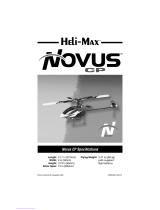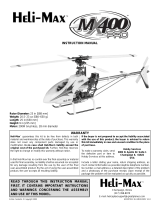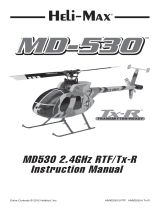Heli-Max Novus CX User manual
- Category
- Toys & accessories
- Type
- User manual
Heli-Max Novus CX is a high-quality, thoroughly tested helicopter and instructions that provides you with top quality. Novus CX has a sophisticated, working model that functions very much like a full-size helicopter. Because of its performance capabilities, the Novus CX, if not assembled and operated correctly, could possibly cause injury to yourself or spectators and damage to property. You must assemble the model according to the instructions. Do not alter or modify the model, as doing so may result in an unsafe or unflyable model.
Heli-Max Novus CX is a high-quality, thoroughly tested helicopter and instructions that provides you with top quality. Novus CX has a sophisticated, working model that functions very much like a full-size helicopter. Because of its performance capabilities, the Novus CX, if not assembled and operated correctly, could possibly cause injury to yourself or spectators and damage to property. You must assemble the model according to the instructions. Do not alter or modify the model, as doing so may result in an unsafe or unflyable model.
















-
 1
1
-
 2
2
-
 3
3
-
 4
4
-
 5
5
-
 6
6
-
 7
7
-
 8
8
-
 9
9
-
 10
10
-
 11
11
-
 12
12
-
 13
13
-
 14
14
-
 15
15
-
 16
16
-
 17
17
-
 18
18
-
 19
19
-
 20
20
-
 21
21
-
 22
22
-
 23
23
-
 24
24
-
 25
25
-
 26
26
-
 27
27
-
 28
28
-
 29
29
-
 30
30
-
 31
31
-
 32
32
-
 33
33
-
 34
34
-
 35
35
-
 36
36
Heli-Max Novus CX User manual
- Category
- Toys & accessories
- Type
- User manual
Heli-Max Novus CX is a high-quality, thoroughly tested helicopter and instructions that provides you with top quality. Novus CX has a sophisticated, working model that functions very much like a full-size helicopter. Because of its performance capabilities, the Novus CX, if not assembled and operated correctly, could possibly cause injury to yourself or spectators and damage to property. You must assemble the model according to the instructions. Do not alter or modify the model, as doing so may result in an unsafe or unflyable model.
Ask a question and I''ll find the answer in the document
Finding information in a document is now easier with AI
Related papers
Other documents
-
Reely 2282651 User manual
-
 Interactive Toy Micro Mosquito User manual
Interactive Toy Micro Mosquito User manual
-
 Hobbico Heli-Max 200FP V-Cam User manual
Hobbico Heli-Max 200FP V-Cam User manual
-
E-flite Blade 400 3D User manual
-
E-flite Blade 400 3D User manual
-
E-flite Blade CP User manual
-
E-flite Blade CP User manual
-
E-flite EFLH3000 User manual
-
 Century Helicopter Products Swift User manual
Century Helicopter Products Swift User manual
-
E-flite Blade CP Pro 2 User manual













































